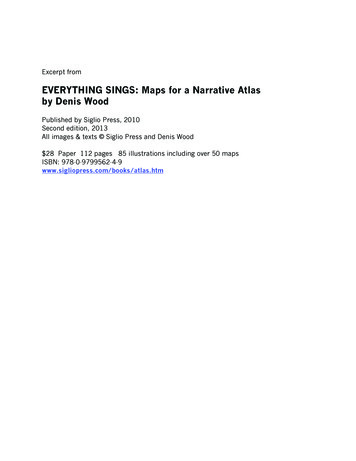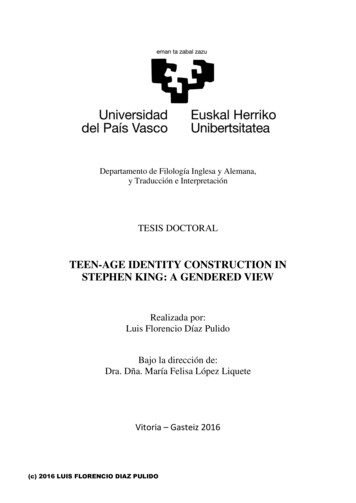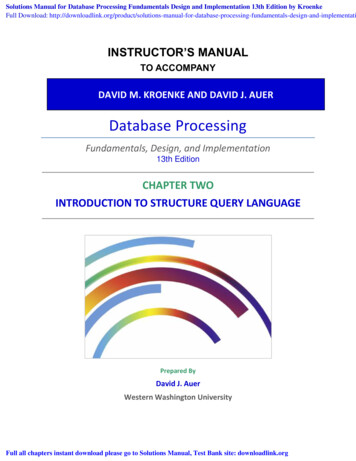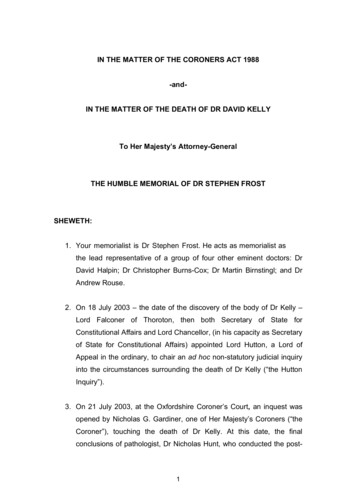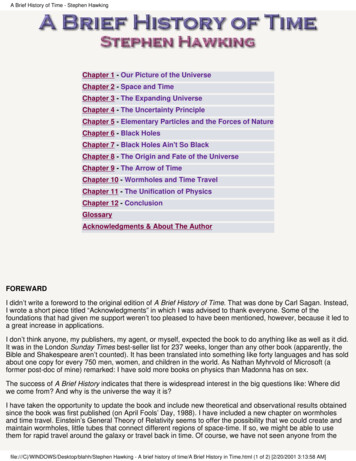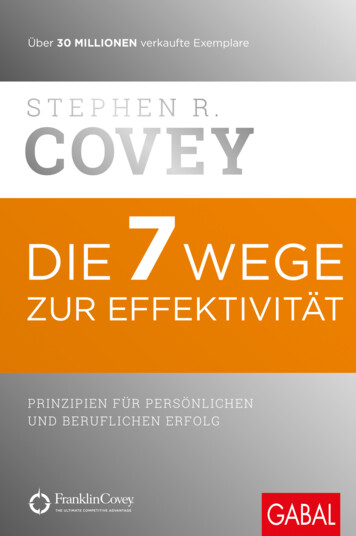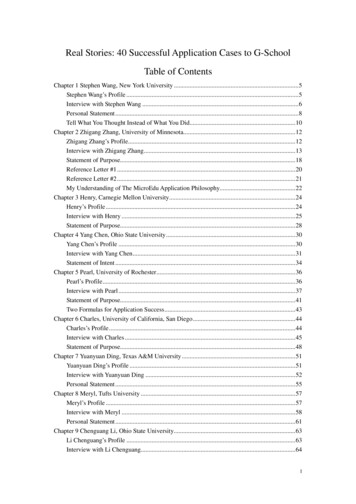
Transcription
PERSISTENT OPERATING LOSSES AND CORPORATE FINANCIAL POLICIES*David J. Denis Stephen B. McKeon June, 2018We thank Harry DeAngelo, Diane Denis, Will Gornall, Matt Gustafson (discussant) David Haushalter, RongbingHuang, Andy Koch, Leming Lin, David McLean (discussant), Jay Ritter, Frederik Schlingemann, Rene Stulz, andparticipants at the SFS Cavalcade, Florida State University Sun Trust Conference, University of Alberta BanffFrontiers of Finance Conference, Mississippi State University Magnolia Finance Conference, Pacific NorthwestFinance Conference, Baruch University, George Washington University, London Business School, NOVA School ofBusiness and Economics, North Carolina State University, Rutgers University, TCU, Tsinghua School of Economicsand Management, Tsinghua PBC, University of British Columbia, University of California-Berkeley, University ofDelaware, University of Illinois-Chicago, University of Oklahoma, University of Porto, University of Texas-Dallas,and University of Wisconsin-Milwaukee for helpful comments. Roger S. Ahlbrandt, Sr. Chair and Professor of Business Administration, University of Pittsburgh,djdenis@katz.pitt.edu Associate Professor of Finance, University of Oregon, smckeon@uoregon.edu
Persistent Operating Losses and Corporate Financial PoliciesAbstractCoincident with a rise in intangible investment, operating losses have become substantially moreprevalent, persistent, and greater in magnitude since 1970. Loss firms now make up over 30% ofthe Compustat universe and such losses continue for a median of four years. Firms with negativeoperating cash flows account for more than half of the rise in average cash balances over thesample period. Further, firms exhibiting operating losses are now the majority of equity issuers.These companies issue frequently, primarily through private placements, and use the funds raisedin the issue to cover current and subsequent operating losses. We conclude that the immediate andexpected ongoing liquidity needs of public firms with persistent operating losses have substantiallyaltered corporate financial policies.1
1.IntroductionA growing body of research reports secular changes in the composition and characteristicsof publicly traded U.S. companies. Over the past several decades, U.S. companies have evolvedfrom manufacturing entities to more service and high-tech firms (Kahle and Stulz (2016)).Coincident with this shift, U.S. companies spend less on physical capital, such as property, plantand equipment, and more on intangible capital, such as human capital, product innovations,patents, brand names, information technology, distribution systems, and customer relationships.Recent studies (e.g., Falato, Kadyrzhanova, and Sim (2016)) estimate that intangible capital nowmakes up more than 50% of net assets for the average company.Investment in intangibles differs from investment in physical capital in two importantrespects. First, while expenditures on physical capital are initially capitalized on the firm’s balancesheet and then depreciated over time, expenditures on intangibles are expensed immediately and,therefore, have a direct impact on firm profitability. Second, while investments in physical capitaltend to scale with sales in an approximately linear fashion, multiple years of intangible investmentare often required before yielding positive increments to sales and, ultimately, profits.In this study, we show that the shift to more intangible capital is associated with dramaticchanges in profitability patterns and corporate financing policies among U.S. public companies.Specifically, we document that not only have operating cash flows become more volatile (asreported in Bates, Kahle, and Stulz (2009)), they are now much lower for a considerable subset ofU.S firms. In the 1950s, about 2% of public firms listed in Compustat reported operating losses(defined as negative cash flow from operations). In contrast, the period since 1980 has beencharacterized by an explosion in the percentage of public firms with negative cash flow (CF), risingfrom 9% in 1979 to over 30% in several recent years.2
We further show that for most firms in recent years, operating losses are not a transitoryphenomenon. Until approximately 1990, firms that reported an operating loss in one year had agreater than 50% chance of reporting positive operating earnings in the following year. However,it is increasingly the case that firms that lose money on operations this period are likely to losemoney next period as well. For example, less than 25% of the firms that reported negative CF in2015 subsequently reported positive CF in 2016, and the median ‘run’ of negative cash flow isnow four years.Furthermore, the magnitude of operating losses has grown substantially overtime. In the 1970s, firms in the bottom decile of operating cash flow exhibited annual losses equalto 11% of assets, on average. In the 2000s, these average losses have ballooned to 58% of assets.Finally, we report that the characteristics of firms exhibiting negative cash flow havechanged substantially as well. In the 1970s, the typical company with negative cash flowsdisplayed characteristics typically associated with financially troubled firms: e.g., lowmarket/book, high leverage, and negative growth rates in revenues and employees. By contrast,as negative cash flows have become more pervasive, persistent, and larger in magnitude, thecharacteristics of firms with negative cash flows have evolved to resemble those of more highlyvalued, growth firms: e.g., high market/book, low leverage, high investment in intangibles, andhigh growth rates in sales and employees.Because the number of listed companies has sharply decreased in recent years [Doidge,Karolyi, and Stulz (2017)], we argue that these patterns are unlikely to be due to an increasedsupply of unprofitable firms going public at an earlier life cycle. Similarly, our own evidence onrates of delistings through acquisitions suggests that the profitability patterns that we documentare not due to the disappearance of profitable firms through going private transactions. The datamost strongly support the view that the evolution of profitability is driven by the growth in3
intangible investment. Indeed, if we measure operating cash flow before estimates of intangibleinvestment have been deducted, growth in the frequency of operating losses over the past fortyyears is virtually nonexistent.Persistent operating losses create immediate and ongoing liquidity needs that must be metby existing internal resources or external finance (or both). We show that firms expecting suchlosses behave differently than firms with positive cash flow on several dimensions of corporatefinancial policy such as cash holdings, equity issuance frequency, and cash savings from issuance.Between 1970 and 2015, average cash holdings as a percentage of total assets increase by a striking580% (from 6.6% of assets to 45% of assets) for firms with negative operating cash flow, ascompared with 90% (8.6% of assets to 16.3% of assets) for firms exhibiting positive cash flow.Firms with negative cash flow thus account for more than half of the increase in average cashbalances of U.S. firms reported in Bates, Kahle, and Stulz (2009).1Traditionally, the precautionary demand for cash, dating back to Keynes (1936), has beenframed within a context focused on the second moment of the distribution of cash flow. That is,in the presence of financing frictions, firms stockpile cash from past profits as insurance againstpossible future adverse cash flow shocks that could lead to underinvestment. However, when thefirst moment of the cash flow distribution is negative, it is likely that the demand for cash stemsmore from the expected level of cash flow than from its volatility. In other words, the cashstockpile is not solely a precaution against the possibility of underinvestment induced byunexpected financing needs. It is a deliberate plan to finance near term operational needs under1Note that we are referring to increases in average cash balances. See Faulkender, Hankins, and Petersen (2017) forevidence on the role of repatriation taxes in explaining the rise in aggregate cash balances among U.S. firms. We latershow that our findings are not affected by the repatriation tax issue.4
an expectation of negative cash flows. Moreover, rather than the source of this cash being pastprofits that have been stockpiled, firms with persistent losses are forced to raise funds externally.Consistent with Gao, Ritter, and Zhu’s (2013) findings for IPOs and Fama and French’s(2004) evidence on new lists, we find that over the past four decades, negative cash flow firmsrepresent an increasing proportion of firm-initiated equity issuances (IPOs, SEOs, and privateplacements). 2 In every year but one since 1989, the majority of firms issuing equity report negativeoperating cash flows (CF) for that fiscal year. In the last year of our sample, 2016, negative CFissuers outnumber positive CF issuers 2 to 1. In addition, we find that equity issues of firms withnegative operating cash flow are overwhelmingly private placements in recent years. Such privateplacements account for approximately 90% of the equity issues for negative cash flow firms in thelast five years of our data. By contrast, the majority of equity issues for positive cash flow firmsover the same period are public seasoned equity offerings (SEOs).Firm-initiated equity issues typically represent a substantial cash inflow to the firm andMcLean (2011) argues that cash savings from equity issuance has been increasing over time.Additionally, Huang and Ritter (2017) find that immediate cash needs are an importantdeterminant of equity issues and that firms save, on average, 65% of the proceeds from equityissues in cash at year-end.We illustrate the importance of operating losses to these patterns by scaling each equityissuer’s post-issue cash balances by the magnitude of the company’s cash burn rate. 3 This scaledmeasure, commonly called “runway” within the venture capital industry, represents an estimate of2Firm-initiated equity issues are defined as stock issuances that exceed 3% of market equity. This definition capturesthe vast majority of IPOs, SEOs, and private placements while excluding most employee-initiated issuances such asESPPs and the exercise of stock options (McKeon, 2015).3We define monthly burn rate as –[Operating CF-Dividends-Capital Expenditures] divided by twelve. For example,a firm that reports negative CF of 100MM and capital expenditures of 20MM annually has a monthly burn rate of 10MM. Firms generating positive free cash flows do not have a burn rate.5
how many months a firm with negative cash flows can continue to operate at the same rate withoutan infusion of external capital. Ceteris paribus, equity issuers could increase runway by increasingissuance size and stockpiling cash. However, we find that the median runway after issuance hasstayed within the same range for decades, typically between 6 and 18 months, and, most notably,exhibits no time trend over the past two decades, a period during which average cash balanceshave exploded. In other words, cash savings from issuance have increased substantially, but burnrates have also risen concomitantly. The implication is that firms with high burn rates rapidlydeplete their cash balances, but frequently replenish these holdings through private equityfinancings. We confirm this in simulations demonstrating that within a given calendar year, cashbalances of negative operating cash flow equity issuers range between 25% and 82% of assets.Ours is not the first study to document secular decreases in the profitability of publiclytraded U.S. firms. Fama and French (2004) report that the profitability of newly listed firms hasbecome increasingly left-skewed and that, as these firms are integrated into the economy, overallprofitability becomes more left-skewed as well. Similarly, Kahle and Stulz (2017) document adecline in average profitability rates among U.S. firms, though aggregate profits have not declined[see DeAngelo, DeAngelo, and Skinner (2004)] and are increasingly concentrated among thelargest, most profitable firms. We extend this literature by (i) showing that the secular trend inprofitability is not just a ‘new lists’ effect; (ii) documenting the increased persistence andmagnitude of operating losses; and (iii) linking these trends to the growth in intangible investmentand to secular changes in corporate financial policies.Other prior studies have investigated financial policies in firms exhibiting losses. Forexample, DeAngelo, DeAngelo, and Skinner (1992) find that dividend decreases are stronglyassociated with the presence of losses, particularly if these losses are persistent. Other studies6
(e.g., Duchin Ozbas, Sensoy (2010) and Campello, Graham, and Harvey (2011)) show thatfinancially weaker firms have difficulties raising capital, particularly in market downturns. Incontrast to the troubled firms analyzed in these prior studies, we show that in recent years, firmswith persistent operating losses are high-growth firms that are able to frequently raise equitycapital.Our study also contributes to three related strands of the literature. The first seeks tounderstand the magnitude of cash balances among U.S. firms and why average balances havegrown so dramatically in recent years. Our findings complement and extend those from studiesthat ascribe a role for increased precautionary demands due to uncertainty in future financing needs[e.g. Bates, Kahle, and Stulz (2009)], and for increased costs of repatriating foreign earnings [e.g.,Faulkender, Hankins, and Petersen (2017)] in explaining high cash balances. We show that, inaddition to these factors, an increased demand for operational cash to fund immediate, andexpected ongoing liquidity needs is an important determinant of observed cash balances. In thissense, our findings complement those of Begenau and Palazzo (2017) and Falato, Kadyrzhanova,and Sim (2016) who link the growth in cash balances to the growth in R&D and other forms ofintangible capital. Our study differs in that we show that the cash accumulation among firms withhigh intangible investment does not represent precautionary savings from past profits, but ratheris a byproduct of firms raising equity finance in advance of predictable, large operating losses.Our findings also provide a potential explanation for the finding in Pinkowitz, Stulz, andWilliamson (2016) that differences in average cash balances between U.S. firms and their foreigncounterparts are driven by a small set of U.S. firms with very high R&D expenditures. We showthat high cash balances of high R&D firms are concentrated among those firms with persistentoperating losses.7
Second, our findings extend the literature on the motives for equity issuance and sourcesof equity finance. Kim and Weisbach (2008) report that additions to cash holdings are the primaryuse of equity issue proceeds in a large international sample of IPOs and SEOs, which implies thatcash stockpiling is an important motive for equity issuance. DeAngelo, DeAngelo, and Stulz(2010) report that most SEO issuers would have been unable to fund current operating plans in theabsence of the equity issue. They thus attribute the issuance decision to the need to fund near-terminvestment. Our findings indicate that equity issuers in recent years are increasingly characterizedby ongoing operating losses and, therefore, high cash burn rates. They not only have immediatefunding needs, but also a need to stockpile cash to fund anticipated near-term future fundingshortfalls. Nonetheless, this stockpile is of short duration, requiring the firms with persistentoperating losses to issue equity far more frequently than has been documented in the prior SEOliterature. The issuances are topping up the stockpile on a regular basis, but the firms are burningthrough the stockpile rapidly. The frequency of issuance is consistent with a staging of capitalinfusions of the type reported for newly public firms in Hertzel, Huson, and Parrino (2012).In addition, the predominance of private placements as a source of finance for negativecash flow firms in our data complements prior studies of private investments in public equity(PIPEs) showing that PIPEs are more common for firms that are likely to face substantial frictionsin the public debt and equity markets. 4 Our data indicate that such firms are now the typical equityissuer and that more than 90% of the equity issues of negative cash flow firms in recent years areprivate placements. Unlike the PIPE issuers of prior studies, however, the typical negative cashflow equity issuer in recent years is not a financially troubled firm. They are investing heavily inintangibles, are growing rapidly, and exhibit substantial future growth opportunities.4See, for example, e.g. Brophy, Ouimet, and Sialm (2009) and Lim, Schwert, and Weisbach (2017).8
Finally, our findings have implications for the empirical literature that models cashbalances as a linear function of firm, country and institutional characteristics. These studiestypically include contemporaneous cash flow among the set of variables that capture the firm’ssources and uses of funds and, therefore, its operating cash needs. Our findings imply that suchmodels have become increasingly misspecified as the distribution of firms has shifted towardsfirms with persistent operating losses. Because these firms exhibit unusually high cash balances,existing models that ignore this nonlinearity systematically underestimate ‘normal’ cash holdingsfor firms with persistent negative cash flows.The rest of the study progresses as follows: Section 2 documents the rise in firms withnegative operating cash flows. Section 3 reports results explaining how the rise in corporate cashholdings is related to operating losses. Section 4 analyzes the external financing patterns of firmswith operating losses. Section 5 discusses implications of our findings, and Section 6 concludes.2.Descriptive evidence on operating lossesIn this section, we present descriptive evidence on the frequency, persistence andmagnitude of operating losses, discuss potential underlying reasons for these patterns, anddocument changes over time in the characteristics of firms exhibiting operating losses.2.1. Patterns in operating lossesThe main sample consists of all publicly-traded U.S firms with total assets greater than 5million (in 2016 dollars) between 1970 and 2016. The data are obtained from the Compustatdatabase, Industrial Annual file. Historically regulated firms such as financial firms (SIC codes6000–6999) and utilities (SIC codes 4900–4999) are excluded, as are firms missing data necessaryfor the calculation of cash ratios. We exclude pre-IPO data by requiring the observation to have a9
market price. Within this sample, we identify firm-initiated equity issues such as IPOs, SEOs, andprivate placements, using the method detailed in McKeon (2015); specifically, those issues inwhich proceeds from common stock issuance are greater than 3% of end-of-period market equity.We begin by documenting the prevalence of operating losses over time. We define anoperating loss as a negative cash flow from operations as reported on the statement of cash flows.Prior to 1987, firms were not required to report cash flow from operations. When this figure ismissing, we calculate an approximation as described in the Appendix. Figure 1 plots thepercentage of the sample that reports negative operating cash flows each year since 1960. The riseis striking. In the early part of the sample, negative operating cash flows are almost non-existent.Despite four recessions between 1960 and 1980 (as defined by the National Bureau of EconomicResearch (NBER)), the percentage of firms with negative cash flow exceeds 10% only three times.Since 1990, however, it has rarely been less than 25%. By 2016, the final year in the sample,nearly 30% of the sample firms report negative operating cash flows.In addition to the increased prevalence of negative cash flows, we find that it is increasinglythe case that firms are experiencing persistent negative cash flows rather than negative cash flowsthat occur due to a temporary shock. Figure 2 illustrates a strong time trend in the persistence ofnegative cash flows. Panel A reports that in the 1970’s and 80’s most firms that experiencednegative cash flows returned to positive cash flows in the following year. By contrast, less thanone-fourth of firms that reported negative cash flow in 2015 followed up with positive cash flowin 2016. Panel B reports the average number of years, including the current year, of consecutivenegative cash flows. By construction, the lower bound of 1.0 represents a situation in which everyfirm reporting negative cash flow in a given year had positive cash flow in the prior year.Consistent with panel A, this measure exhibits a strong time trend, peaking in the last year of the10
sample at nearly four years. This implies that the occurrence of negative cash flows is not likelyto be surprising or unexpected for most firms in recent years. Rather, these firms are operatingwith the intention and expectation of extended cash flow deficits.To provide more formal evidence on the persistence of negative cash flows, we estimate a1st order autoregressive (AR(1)) model of cash flow (CF). Specifically,𝐶𝐶𝐶𝐶𝑡𝑡 𝛼𝛼 𝜑𝜑𝐶𝐶𝐶𝐶𝑡𝑡 1 𝜀𝜀𝑡𝑡We estimate the AR(1) model annually on the sample of firms that report negative cashflow at time t. The coefficients (𝜑𝜑) and 95% confidence bands are plotted in Figure 3. Similar toFigure 2, the AR(1) model indicates increasing persistence in negative cash flows over time. Inthe 1970’s and 80’s, prior year cash flow had little explanatory power for observations of negativecash flow. Starting in the 1990’s, prior year cash flow became a very strong determinant ofnegative cash flow in the current year.Finally, it is noteworthy that the magnitude of negative cash flow has grown substantiallyover time. Table 1 reports average CF/assets for the ten deciles during four subperiods: 1970–1979, 1980–1989, 1990–1999, and 2000–2016. All deciles report lower cash flows over time, butwithin the lowest decile the change is most dramatic. In the 1970’s the average firm in the lowestdecile reported cash flow equal to -11% of assets. During the 2000–2016 sub period, the averagewas -58% of assets. Put another way, firms in this decile burn an average of almost 5% of assetsper month even before accounting for capital expenditures.Taken together, Figures 1 through 3, and Table 1 highlight three stylized facts about theevolution of firms reporting negative cash flows: Negative cash flows are vastly more prevalent,more persistent, and the magnitude of average negative cash flows within the lowest decile hasgrown fivefold. Further, Figure 4 charts the distribution of cash flow for two sub periods at thebeginning and end of the sample period and reveals that not only has the density in the center of11
the distribution shifted to the left, but there has been dramatic increase in the proportion of firmswith very large negative operating cash flows.In the 2000s, five percent of the firm-yearobservations exhibit operating losses of at least 50% of the book value of the firm’s assets.2.2. Why have operating losses grown over time?One possible explanation for the growth in the proportion of firms with negative operatingcash flow is that it has become easier for negative cash flow firms to raise equity capital in publicmarkets in recent years. 5 If firms are increasingly going public at an earlier stage of their lifecycle, the patterns that we document could be due to an increased supply of young, unprofitablefirms in the publicly traded universe. Contrary to this view, however, Doidge, Kahle, Karolyi, andStulz (2018) report that the number of listed firms in the U.S. has fallen dramatically since 1997,as has the propensity of smaller firms to list. Moreover, Kahle and Stulz (2017) report that themedian firm age among public firms has more than doubled in the past twenty years. Over thissame period, the proportion of firms with negative operating cash flow has remained high and thepersistence of these losses has increased.Another possibility is that firms with positive, stable profits might disproportionately betargets of buyouts or other acquisition attempts. However, we find no evidence that this is thecase. In untabulated results, we observe that delisting rates attributed to M&A are similar fornegative and positive cash flow firms throughout the sample period.The most plausible explanation for the growth in negative cash flow firms is thatinvestment has shifted over time from investment in tangible assets to investment in intangible5For example, Jay Ritter notes that "In the early Eighties, the major underwriters insisted on three years of profitability.Then it was one year, then it was a quarter. By the time of the Internet bubble, they were not even requiring profitabilityin the foreseeable future." (Rolling Stone, April 5, 2010).12
assets. 6 Intangible investment includes not only investments in knowledge capital (e.g., R&D),but also investments in organizational capital (e.g., human capital development, customerrelations, brand name, information technology). The latter are likely to be a component of thecompany’s selling, general, and administrative (SG&A) expenses. 7Importantly, theseinvestments in intangible assets are expensed immediately and, therefore, reduce operating cashflows. By contrast, investments in tangible assets (e.g. property, plant, and equipment) arecapitalized in the balance sheet, then gradually depreciated over time.Moreover, becauseintangible investments are more commonly multi-year in nature, a shift from tangible to intangibleinvestment will increase both the observed frequency of firms with negative operating cash flowand the persistence of those negative cash flows.To demonstrate the empirical link between increased intangible investment and negativeoperating cash flows, Figure 5 plots the evolution of R&D/Assets (Panel A) and SG&A/Assets(Panel B) for firms in the top and bottom deciles of operating cash flow each year. The resultsindicate that among high cash flow firms, there has been little to no increase in intangibleinvestment. By contrast, among firms in the bottom decile of operating cash flow, intangibleinvestment has grown substantially over time. In the early part of our data, there is little differencebetween the R&D and SG&A expenditures of high cash flow and low cash flow firms. By the endof our sample, intangible investment expenditures of low cash flow firms are many times higherthan those of low cash flow firms.6Kahle and Stulz (2017), for example, report that average capital expenditures as a percentage of assets has declinedby 50% since 1975, while average R&D expenditures have risen five-fold so that average expenditures on R&D nowexceed those of capital expenditures.7See, for example, Lev and Radhakrishnan (2005), Eisfeldt and Papanikolaou (2013), and Falato, Kadyrzhanova, andSim (2015). In addition, Cook, Kieschnick, and Moussawi (2018) argue that these firms are more likely to useoperating leases to obtain operating assets than to purchase assets. Such operating lease expenses also appear in thecompany’s SG&A expenses.13
In Figure 6, we demonstrate that the growth in intangible investment (particularly in theform of SG&A expenditures) is the primary driver behind the rising frequency of negativeoperating cash flow firms.We first compute a measure of operating cash flow before R&Dexpenditures (OCFRD) and document the percentage of firms with negative OCFRD over time.Not surprisingly, as R&D expenditures have grown over time, the proportion of firms withnegative OCFRD becomes much smaller than the proportion of firms with negative cash flow.Nonetheless, the fact that the percentage of firms with negative OCFRD has grown over time andis between 20% and 30% over the past two decades suggests that the increased frequency ofnegative operating cash flow firms that we observe is not solely a byproduct of rising R&Dexpenditures over time.Therefore, we next compute a second measure of operating cash flow before anyexpenditures on R&D or the portion of SG&A that captures intangible investment. We label thismeasure OCFRDSGA. Because we are unable to identify precisely the portions of SG&A thatrepresent operating costs that support current profits and those that represent intangible investment,we assume that the operating cost component of SG&A is constant over time and equal to 30% oftotal assets (approximately the level of SG&A in the early years of the sample). We then categorizeany SG&A over 30% of total assets as being intangible investment. 8 As shown in Figure 6, if wemeasure the percentage of firms reporting negative operating cash flow before any expenditureson R&D or other intangibles, there is little change over time in the proportion of firms withnegative operating cash flow.We conclude, therefore, that the growth in the frequency,8Prior studies (e.g. Hulten and Hao (2008), Eisfeldt and Papanikolaou (2014), Zhang (2014), and Peters and Taylor(2017) similarly have to make assumptions about the mix of operating costs and intangible investment in SG&A.These studies assume that SG&A is comprised of 70% operating costs and 30% intangible investment. Because weobserve large increases over time in SG&A and can see no reason why operating costs would increase over time, wedo not assume a constant mix of operating costs and intangible investment. Rather, our approach assumes that thegrowth in SG&A is due to growth in intangible investment.14
persistence, and magnitude of negative operating cash flows is tied closely with the shift a
David J. Denis. . Stephen B. McKeon . [see DeAngelo, DeAngelo, and Skinner (2004)] and are increasingly concentrated among the largest, most profitable firms. We extend this literature by showing that the(i) secular trend in profitability is not just a 'new lists' effect; (ii) documenting the increased persistence and
